“Robots, School Girls, Fancy Toilets: Everything You Expect From Japan And So Much More”
2018/5/24
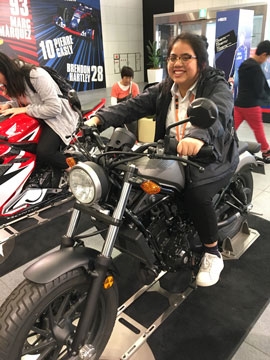
By Karen Tang
Karen Tang is a student of Abraham Lincoln High School. She visited Japan in March 2018 as part of the Kakehashi Project, a Japanese Government educational exchange program.
My 2017 Kakehashi cohort and I are a rowdy group of San Franciscan teenagers enrolled in our high school’s Japanese program, so we thought that we had Japan figured out. As a high school senior, I had already heard plenty about Japan from my Japanese class. I knew about the amiable citizens, the almost too convenient convenience stores, and the derriere-spraying toilets. I live in San Francisco, a city in love with every facet of Japanese culture from its fashion to its history to its pop culture; our lively Japantown and scenic Japanese Tea Garden are a testament to that. For me, Japan was something familiar yet distant. I could do as much research as I wanted, but only until I experienced walking through the streets of Japan on my own two feet could I truly understand the unique culture of Japan.
Day one was surreal. After years of studying Japanese and looking at the country from afar through television, video games, and news pieces, I finally stepped on Japanese ground at the Haneda Airport. Oh wow, there’s kanji everywhere! I know what that one means! I don’t know what the rest of those mean! I probably should have studied more! The exhilaration of exploring a foreign country I’ve heard so much about lingered long after my initial introduction to Japan. What I heard was true -- the floors were spotless, the toilets were spectacular, the people were polite. To be honest, I was quite nervous to be an American visiting Japan. I knew that Japanese locals were generally polite, but I was wary that Americans have a bad reputation overseas about being the loud tourist-y types and are sometimes frowned upon. However, my worries were dissipated when I received bright smiles and warm welcomes from the Kakehashi Program’s lovely tour guides. They seemed genuinely glad to welcome us, and I was more than happy to be there.
Just the bus ride from the airport to our hotel revealed the busy, bustling life of Tokyo. Eye-catching neon billboards flew by, convenience stores and quaint restaurants lined the streets, and adorably tiny trucks drove past us. Men and women in stylish suits or overcoats hustled along the streets. Even a mere glimpse of the metropolis made the lively, hectic life of Japan clearly evident.
The need for all things convenient and efficient to allow this busy lifestyle can be seen everywhere, such as the dozens of convenience stores scattered around every block that sell everything from packaged lunches, notebooks, and white collared shirts. Our visit to the Honda Welcome Plaza demonstrated just how far Japanese engineers will go to make people’s lives easier and more productive. In the showroom, we took goofy photos posing on Honda’s sleek, shiny motorcycles and in their new, nifty cars, but those weren’t even the most impressive technological innovations.
Karen Tang is a student of Abraham Lincoln High School. She visited Japan in March 2018 as part of the Kakehashi Project, a Japanese Government educational exchange program.
My 2017 Kakehashi cohort and I are a rowdy group of San Franciscan teenagers enrolled in our high school’s Japanese program, so we thought that we had Japan figured out. As a high school senior, I had already heard plenty about Japan from my Japanese class. I knew about the amiable citizens, the almost too convenient convenience stores, and the derriere-spraying toilets. I live in San Francisco, a city in love with every facet of Japanese culture from its fashion to its history to its pop culture; our lively Japantown and scenic Japanese Tea Garden are a testament to that. For me, Japan was something familiar yet distant. I could do as much research as I wanted, but only until I experienced walking through the streets of Japan on my own two feet could I truly understand the unique culture of Japan.
Day one was surreal. After years of studying Japanese and looking at the country from afar through television, video games, and news pieces, I finally stepped on Japanese ground at the Haneda Airport. Oh wow, there’s kanji everywhere! I know what that one means! I don’t know what the rest of those mean! I probably should have studied more! The exhilaration of exploring a foreign country I’ve heard so much about lingered long after my initial introduction to Japan. What I heard was true -- the floors were spotless, the toilets were spectacular, the people were polite. To be honest, I was quite nervous to be an American visiting Japan. I knew that Japanese locals were generally polite, but I was wary that Americans have a bad reputation overseas about being the loud tourist-y types and are sometimes frowned upon. However, my worries were dissipated when I received bright smiles and warm welcomes from the Kakehashi Program’s lovely tour guides. They seemed genuinely glad to welcome us, and I was more than happy to be there.
Just the bus ride from the airport to our hotel revealed the busy, bustling life of Tokyo. Eye-catching neon billboards flew by, convenience stores and quaint restaurants lined the streets, and adorably tiny trucks drove past us. Men and women in stylish suits or overcoats hustled along the streets. Even a mere glimpse of the metropolis made the lively, hectic life of Japan clearly evident.
The need for all things convenient and efficient to allow this busy lifestyle can be seen everywhere, such as the dozens of convenience stores scattered around every block that sell everything from packaged lunches, notebooks, and white collared shirts. Our visit to the Honda Welcome Plaza demonstrated just how far Japanese engineers will go to make people’s lives easier and more productive. In the showroom, we took goofy photos posing on Honda’s sleek, shiny motorcycles and in their new, nifty cars, but those weren’t even the most impressive technological innovations.

The best Honda had to offer was showcased in a demonstrational presentation. After we took our seats, a chic young woman stepped onstage and a peculiar black-and-white, one-wheeled mechanism rolled in to join her. The lady sat on the device and traveled from one side of the stage to the other just by tilting her weight towards where she wanted to go. The video screen behind her explained that this unicycle-like mechanism, UNI-CUB, is a personal mobility device meant to aid those unable to walk. It balances all on its own, is operated completely hands-free, and was designed specifically to match the pace of your average walker so that the disabled may fully integrate with Japan’s busy society. In fact, on Honda’s website it states that UNI-CUB was made with a “design promoting harmony with people.” Looking past the practicality and relief it may bring to the disabled, the design is just plain cute. It’s characteristically Japanese -- small, round, simple but stylish. But of course, this is Japan, so the cute doesn’t stop there. After UNI-CUB left the stage the adorable 130 cm (4 feet 3 inches) robot buddy ASIMO was greeted with our unanimous cries of awwwww as he sauntered onto the stage. As we squealed he waved and jumped and ran. If all robots turn out this cute, then maybe the inevitable robot uprising won’t be so bad. But our little buddy wasn’t made to conquer -- ASIMO was designed to help with daily tasks to make home life even easier. UNI-CUB and ASIMO, two of Japanese latest achievements in cutting-edge technology, are a testament to Japan’s dedication to allowing all of its citizens to live active, productive lives.
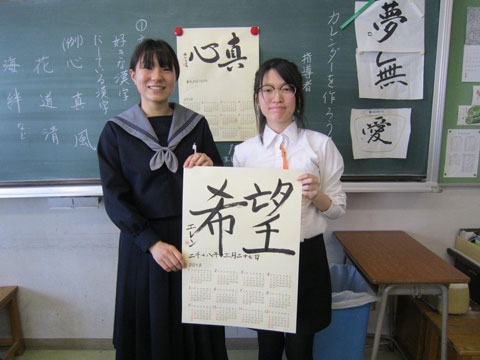
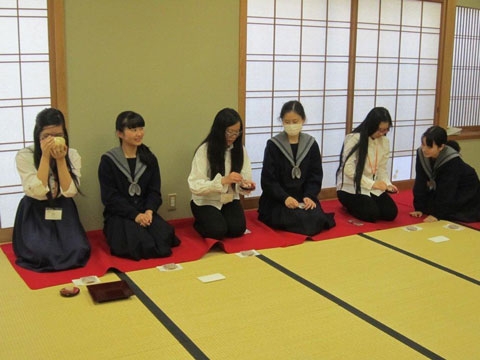
We all know that Japan produces some of the world’s most fascinating, innovative technology, but it’s also home to the everyday homes, parks, and schools that we’re all familiar with. We had a chance to visit one of these quaint schools in Osaka -- Meijo Gakuin High School. At this small all-girls school, we were greeted with smiles by the various teachers, staff, and students that generously took their time off spring break just to host us. We were all especially grateful for their kindness, but even though we knew of their amiability, our initial meeting was still quite nerve-wracking. This was the moment we’ve all been dreading -- actually having to speak Japanese to Japanese people. I really should have studied more. Our cohort and the students of Meiji Gakuin High gathered in a classroom for our introductions. We awkwardly shuffled around in our white dress shirts and green school slippers as the students shyly giggled amongst one another in their navy blue school uniforms. We were afraid of the notion of using our broken Japanese to talk to these native speakers, and clearly they were anxious about practicing their English with us. How could two group of kids from opposite ends of the earth ever hope to communicate, much less relate to each other? However, as we split into groups, toured the school, and engaged in calligraphy and a tea ceremony, it became apparent that despite our cultural differences, we were much more similar than different.
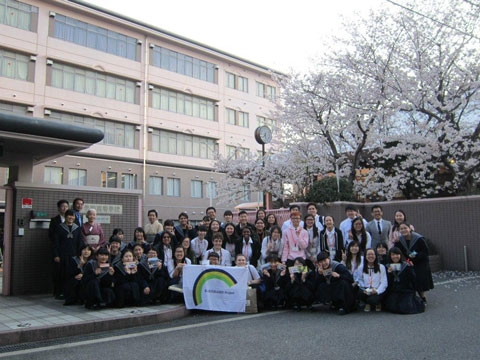
We all struggled to find the right words in Japanese or English to ask each other what kind of music they liked or what hobbies they enjoyed. I was elated to find out that a student loved the band ONE OK ROCK like I did, and many of my friends were ecstatic to find fellow Love Live! fans in the school. I had the pleasure of chatting with Ayano-san, a lovely second-year student, as I drew the sloppiest calligraphy known to man. We all took plenty of silly selfies with one another, laughed at our struggles to walk up the stairs with our slippery slippers, and excitedly exchanged contacts on Instragram, Line, and Snapchat. After only a few hours, we went from strangers separated by a language barrier to newly formed friends who relished in both our similarities and differences. Our final goodbyes as we left for our charter bus were bittersweet as we wanted nothing more but to spend time with our new friends.
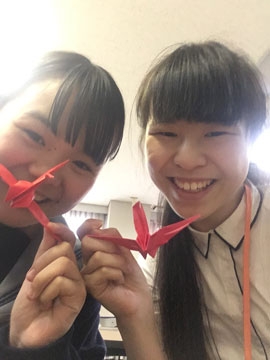
On the bus ride to our hotel that evening, one of our Japanese teachers, Hiroi-sensei, said something that sums up why truly experiencing Japan first-hand is so important. She said something along the lines of, “What you all did today was a crucial first step towards building bridges between countries and maintaining peace. When you go to Japan, meet its people, and befriend them, you’re strengthening this international relationship. Because if you actually know and have friends in another country, you don’t want to make war with them.” This is absolutely true. Before visiting Japan, I saw it as merely a country. A wonderful country for sure, but still just a location. Now, however, it’s the home to beloved friends and the home to many amazing memories I’ll always cherish. I’m now passionate, more than ever, about building and maintaining bridges between Japan and America so we may understand one another, learn from one another, and befriend one another. In fact, as I’m writing this essay, I’m messaging Ayano-san through Line in an effort to strengthen the friendship we began back in Osaka.
Japan is an absolutely wonderful country for a plethora of reasons, including its fascinating technology, socially conscious populace, and kind individuals. But living my experiences vicariously through this essay won’t let you understand even a fraction of what Japan is like -- all you can do it visit there yourself.
Japan is an absolutely wonderful country for a plethora of reasons, including its fascinating technology, socially conscious populace, and kind individuals. But living my experiences vicariously through this essay won’t let you understand even a fraction of what Japan is like -- all you can do it visit there yourself.
